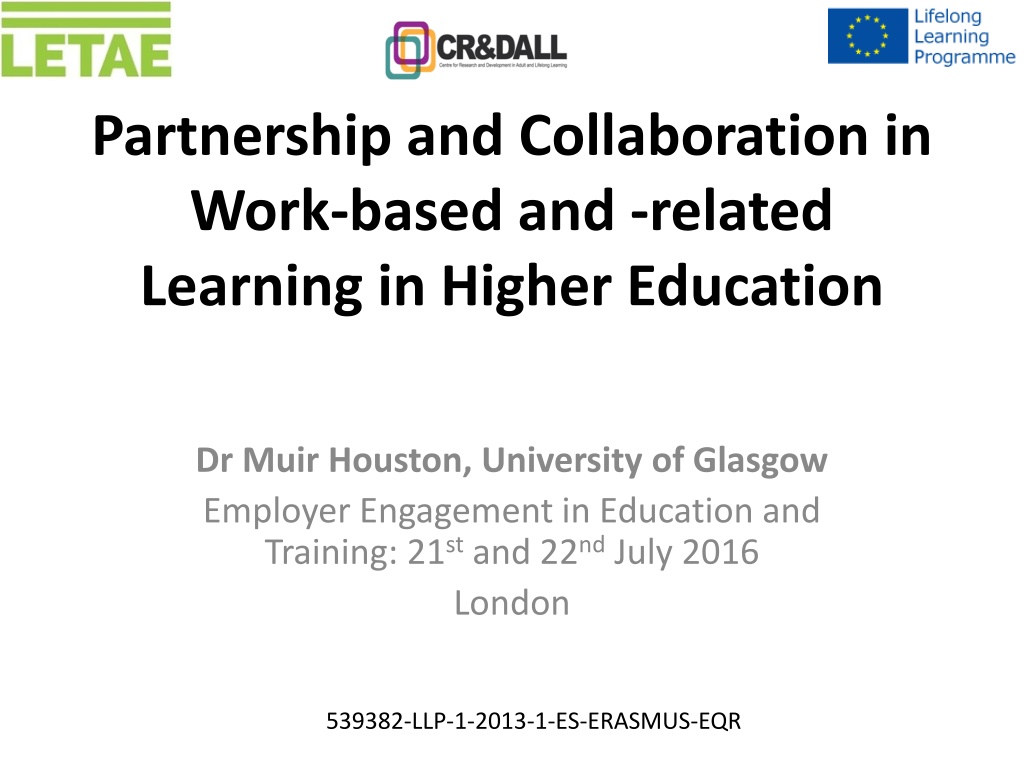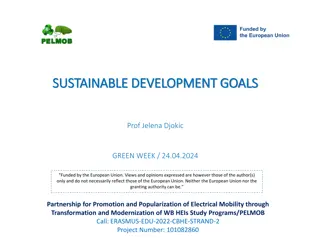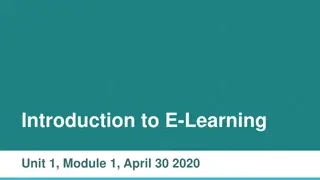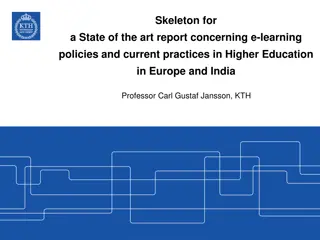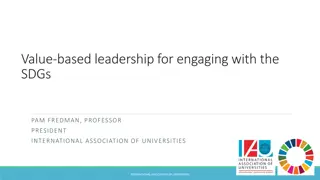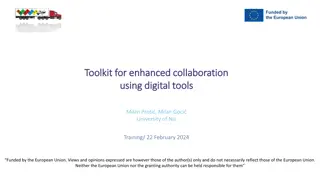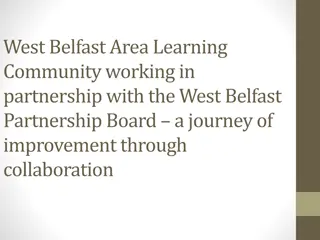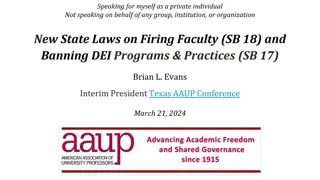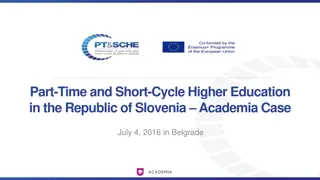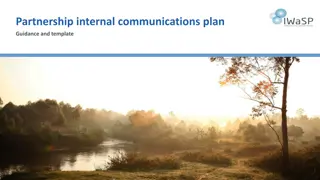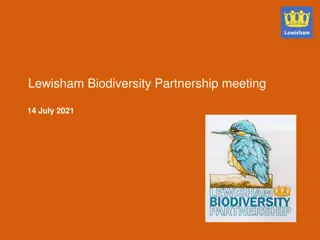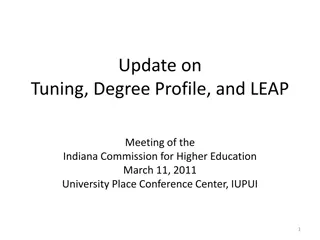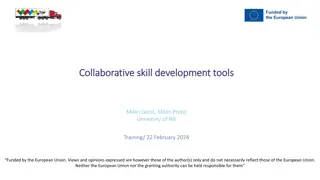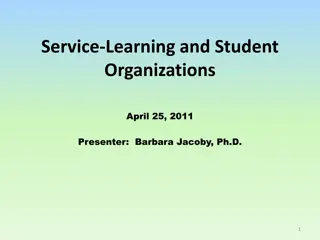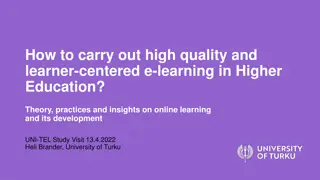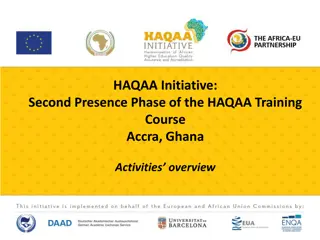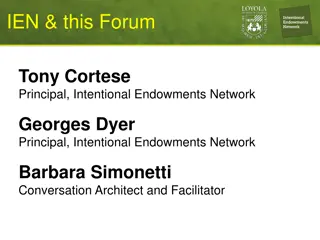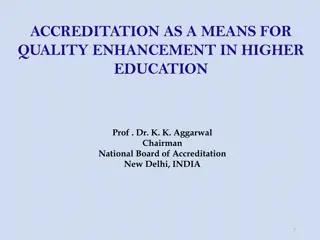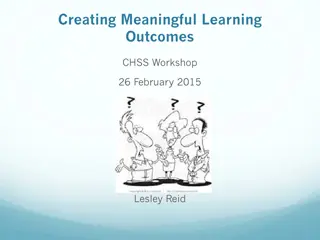Partnership and Collaboration in Work-Based Learning in Higher Education
Work-based and work-related learning in higher education for adult learners is crucial for addressing the skills gap in the labor market. This involves integrating learning and work to enhance skills formation, economic competitiveness, and enterprise renewal. The closer partnership between academic institutions and organizations plays a key role in the development and impact of work-based programs. Collaboration in tertiary-level programs across European countries and Turkey focuses on evolving programs to benefit learners and enterprises.
Download Presentation

Please find below an Image/Link to download the presentation.
The content on the website is provided AS IS for your information and personal use only. It may not be sold, licensed, or shared on other websites without obtaining consent from the author. Download presentation by click this link. If you encounter any issues during the download, it is possible that the publisher has removed the file from their server.
E N D
Presentation Transcript
Partnership and Collaboration in Work-based and -related Learning in Higher Education Dr Muir Houston, University of Glasgow Employer Engagement in Education and Training: 21stand 22ndJuly 2016 London 539382-LLP-1-2013-1-ES-ERASMUS-EQR
Background Work-based and work-related learning in higher education for adult learners is seen as crucial to address the predicted labour market skills gap identified in such EU communiqu s as: New Skills for New Jobs: Anticipating and matching labour market and skills needs; and, An Agenda for new skills and jobs: A European contribution towards full employment as part of the Europe 2020 strategy. It was also explicit in the UK s Leitch Review Prosperity for all in the global economy - world class skills
A review (1996) Government sponsored review of WBL it is the case that the closer integration of learning and work is a central theme of policy debates across Europe about skills formation of the workforce and strategies for economic competitiveness and enterprise renewal (Brennan and Little 1996) Four key reasons underlying current interest in work based learning: (i) economic restructuring and productivity changes; (ii) workplace reorganisation; (iii) knowledge assets as the source of competitiveness; (iv) financing of continuing training (Sommerlad, 1996).
learning for work; learning at work; learning through work learning for work broadly encompassed 'anything which can be labelled vocational ' (delivered in school, college, from television etc.); learning at work related to training and development delivered in-company; learning through work was integrated into the doing of the job In higher education terms, learning for work may well include elements of learning at work and learning through work. (Seagraves et al., 1996: p6)
Original case criteria: 3 case studies in each of the 6 countries Tertiary level work-based or work-related programmes for adult learners (>25) within a cluster of EU Member States (CZ, DE, ES, FL, UK) and Turkey. Originally degree level although this had to be dropped What were we doing: How and in what ways did the collaboration/partnership /programme develop and evolve? What, role, do work- based/-related programmes/courses play in the academic institution? What, role, do work- based/-related programmes/courses play in the organisation? What is the impact on the learner and the enterprise?
Some figures 2007 2014 Male Female Male Female 0-2 3-4 5-8 0-2 3-4 5-8 0-2 3-4 5-8 0-2 3-4 5-8 EU28 27.8 49.0 23.2 30.8 45.5 23.8 23.7 48.4 27.9 24.3 45.0 30.7 CZ 6.1 79.0 14.8 12.8 74.6 12.6 4.8 74.5 20.7 8.8 68.8 22.4 DE 12.6 59.6 27.8 18.6 60.6 20.8 11.3 58.3 30.5 14.9 61.4 23.7 ES 49.7 21.7 28.6 49.0 21.1 30.0 45.2 22.0 32.8 41.6 21.9 36.5 FI 21.7 47.2 31.1 17.3 41.1 16.1 48.7 35.2 10.8 40.7 41.7 48.5 UK 23.5 44.9 31.6 29.8 37.7 32.5 19.6 41.2 22.0 36.1 39.2 41.9 TR 66.9 20.5 12.6 79.8 12.4 7.7 61.3 21.0 17.8 73.6 13.6 12.8
EU28 Spain UK Finland Czech Turkey Germany
Basic information on national preconditions/strategies GE: Rather low relevance of TLL: Successful approach of combing IVET & HE: Dual studies ; combing workplace learning of an apprenticeship and a bachelor programme Established and nation-wide recognised CVET system (Meister, Techniker) ES: Continuous training for people with HE-certificates No priority for universities 2 years NON-Bologna programmes Depending on students demand UK: Long history of TLL Divergence between England and Scotland Fragmentation due to neo-liberalism (market driven approaches) in England More integrated approach in Scotland between VET & HE
Basic information on national preconditions/strategies FI: Lifelong Learning high on the agenda Focus on internationalisation/export of programmes Variety of options: Degree, Professional development, open university programmes Variety of funding mechanisms CZ: No strategy towards TLL Rather short-time programmes/internships Focussing on unemployed TR: LLL important issue since the foundation of Turkey Rather low ratio of tertiary-educated adults Universities offer short-time courses for workforces Open education / distance learning Focussing on unemployed
Case study 1 Bachelor of Arts in Community Development Academic Institution First Cycle (Level 5 EQF; Level 9 SCQF) 3 years full-time Collaboration rather than partnership Professional Accreditation Agency Placement Provider
Entry requirements: Applicants with no formal qualifications are encouraged to apply; all applicants must have at least two days per week of paid or unpaid work in the broad field of community development Format of programme: 1 days Sept to May Years 1 & 2; 1 day per week (academic attendance); Year 3 placement 12-16 hours/week plus reflective practice assessment on students own work (paid/unpaid) in Years 1 & 2 Academic/work-based/-related element Assessment is based 60% on academic assessment and 40% on placement and practice assessment in terms of getting the professional accreditation we have, students have to complete fourteen hundred and fifty hours of community development practice across the three years. (lecturer)
Funding, recruitment, evaluation No tuition fees, access to Student Loans, possible income from existing job in sector Recruitment often through word of mouth in field although also institutional marketing: around 25-30 per year University Academic regulations for the award of degrees apply to assessment, quality and standards Every, .. four to five years the programme has to re- apply for its accreditation, . an HMI inspection type thing, so we have to go through quite a rigorous process in terms of, meeting the specific criteria and the competence.
Impact on learners (1) Support I found the lecturers are extremely supportive, the comments are supportive. I speak to my lecturers. I quite like the lecturers . Extremely approachable. Work- life balance It was extremely complex, and I've had to wake up in the middle of the night two hours a week for weeks leading up to my assignments, to be able to do my assignments. The work/life balance just became really challenging Motivation We realised there was a lot we didn't know and so we started to volunteer So I was, in effect, looking for a course that would relate to what we are doing because I'm an adult of course... I was looking for information and research and programmes and things and then I found the community development course... (female learner, 50)
Impact on learners Entry this course came up here, I realised it was a work-based practice course no formal educational requirements, .. it was all based upon my interview,.. I didn t have experience working with groups within the community, But I spoke to them, Go and get some experience. I d been doing some volunteering, but just one on one, so I got a lot more experience with groups. And that fitted the bill. Placement Already, I mean the brilliant part, brilliant, amazing, dialectic part of the course is I m, where I m working, I m learning so much with the vast experience of the people in the community. The people that have been working in the community centre then also I m bringing the theory to that workplace as well. Future I ll be the most accredited person within that organisation, and that s not to discredit anyone that s there s other people with diplomas in other But in terms of a Glasgow University degree, I will be the most accredited person, and yet, probably the most na ve in terms of (laugh) of what actually works on the job. (Male, 40)
Work-based perspective Community development We've got a gardening project, social gathering place. Walking group, take people out, get them out of the scheme for a while, get them out, a bit of health, getting to see the scenery, all that sort of stuff. Everything's about bringing people together and enabling they social connections to be made. Facilitating placement I do the leading of a group or go and work with the student, do that, and then I'll talk to them about How was that? What did you think about? What did that feel like? How did you manage that? So now what? What are you going to do next? .. How are you going to facilitate the next session? Flexibility Quite often you'll have a student come here with a... desire or a particular interest that they want to work on. They have to do some work with asylum seekers and refugees So sometimes we get specific pieces of work, others it's about their own interests and then I'll see Well, we've got a bit of work here. You could help. (placement manager)
Case study 2 Bachelor in Engineering (Hons.) First Cycle (Level 6 EQF; Level 10 SCQF) Credit Accumulation model with expectation of 6 years part-time Partnership model academic/trade union/employer
Entry requirements True open access practised by academic partner, options for credit transfer and APEL/APL, trade union member and employee of Rolls Royce Format of programme Credit based modular system 30/60 Credit point modules; part-time students but full-time employees 360 credits required for Honours degree Academic /work-based element Work hosted and supported and modules work- related but not work based (exception may be work- based practice project)
Funding, recruitment, evaluation Tuition fees per module ( 452 702 (30 credits) or 833 1076 (60 credits). Workers above income threshold and pay 70 (30 credits) and 140 (60 Credits) balance is paid 50/50 by trade union and employer Recruitment internal and around 10 per year with around 40 at any one time studying modules University academic regulations apply to award of credit and ultimately degree We scheduled meetings with the OU and the employer on site, and we have an overview of the tutor marked assessments so we can see, from the tutor marked assessments, how our members are doing, if they need extra support.
Drivers of the programme We engaged with the employer (Rolls Royce) and we negotiated a learning agreement that set parameters and how we were going to do it . The site shop stewards committees, made the decision that all the shop stewards could take up the union learning rep role so you could understand the agenda and drive it. We made the learning and training part of the collective bargaining structure (UNITE rep) there was a commonality of interest in, predominantly, in engineering and that would be on the B.Eng of the Open University.(UNITE rep) So we engaged with the employer, and we said to Rolls Royce, look, there s a massive under-utilisation of potential, here. Our members have got a huge amount of skills, knowledge and experience. We re looking to get accreditation round that. The challenge will be, then, to you, we re not looking to replace your current undergraduate structures or your graduate structures
Impact on learners Support I see it going on with a lot of the cohorts, a lot of individuals who s taking learning, they buddy up, they help each other. I think people seem more confident that when they ve got a problem they come and ask us . and encourage managers to become the mentor for these individuals and at that, once that happens there would probably be a more full integration. Work Life Study balance Sometimes you haven t the energy or the inclination. Other times you don t have the time and then there s times when you, I mean it s, there can be days where both me and Brian will sit in front of a computer all day and then we have to go home and sit in front of a computer again. Do you know what I mean?
Impact on learners 2 Career There s been guys that have taken up other roles both on the shop floor, taken on more roles within their teams on the shop floor. There s guys also moved into technical functions. And actually, one of our members who s actually now completed his degree he was the first guy to complete his engineering degree has actually transfer there was a redundancy at Inchinnan, there, but he mitigated the threat of redundancy for himself because he moved to Canada, Rolls Royce Canada got a job, a technical job in Rolls Royce Canada and that was on the back of his studies, as well.
Academic/work-based perspective Delivery .. the peer support that started to develop and I think has become a, you know a more important part of it particularly the role of the trade union learning reps who, I mean, we ve got three in East Kilbride that are also doing the OU as well, so they understand the process and, as new people come on board, they can act as work, you know, as trade union mentors for them and provide peer support. that s been one of the key bits of the workplace delivery aspect of it, that, has been really important. So yeah, it s basically an OU model, but with some additional workplace support. Impact But at the end of the day, I mean, the company, I think, have come round to realising what they ve got is a model that will deliver some graduates for them at less cost than anything else that s going on. It s got some workplace support aspect to it, it s got a commitment to the individuals and, you know, so I think that they can see that there s something emerging out of this that s quite different.
Case Study 3 Foundation Degree in Electrical Power Engineering Intermediate First Cycle (Level 5 EQF, SCQF 8) 3 years Sandwich with final year in industry Partnership model between Aston and Scottish and Southern Energy (SSE) with UHI responsible for Scottish provision
Entry Requirements: Two good A-Levels, preferably including Maths or Physics but recruitment through corporate HR Format of programme 26 weeks over two years block release (two to three weeks) Second year at Aston Academic/work-based element Additional in-house courses and third year in Industry Industrial project in 2nd year
Funding, recruitment, evaluation Tuition fees of 7560 per annum but in reality this will be paid by SSE in addition to subsistence costs for attendance Around 60 per year with 24 at UHI In practice this is done by SSE through its corporate recruitment to Trainee Engineer programme (although other companies in sector have been involved in model) Academic regulations apply to academic elements/ on site training for competences overseen by company and recorded in log
Drivers of the programme In 2004 Aston University began discussions with two power engineering utilities regarding the provision of Level 4 and Level 5 training to support senior technicians and Incorporated Engineers working within the sector. The University discussed its outline proposals in November 2005 with Energy and Utility Skills, and subsequent, detailed dialogue with staff from National Grid and Scottish and Southern Energy (SSE) resulted in the development and approval of the employer-led Foundation Degree programme by May 2006. A two-year, block release Foundation Degree in Power Engineering was developed and the first cohort graduated in the Summer of 2007. Lukes, S. (2013) Aston University Work Based Provision for the UK Electrical Power Industry. UALL Conference, Middlesex
Impact on learners My father works for the company and so I knew about the opportunities and a bit about the company in terms of culture and some expectations of what was required and on balance I though starting in the company and being paid was a better option than doing a traditional electrical engineering degree at university. And it was local! (Female, 20) I tried university and did a year at Edinburgh but did not really like it worked as a a chef for a while and then started with SSE on the overhead lines. Did a conversion course at Inverness college to get my maths up to scratch and then one of my pals had just graduated from the SSE programme so I applied. I really like getting out and about, the travel and the variety. (Male, 24)
Impact The drop-out rate is extremely low (< 2% over 5 years, compared with a sector average of 11.3%) and the performance of the students is far higher than average, despite the programme being technically challenging. This is far better than for most other, conventional undergraduate students, and even the low levels of 6.9% at our University. Almost 500 students have graduated from these programmes to date. 26% of graduates have been awarded Distinctions (> 70% overall mark), and a further 36% gained Merit awards (> 60% overall mark). it s a good programme as far as both the company and the trainees are concerned and the retention rates were very high and I mean the guys are coming out twenty-six to about thirty- two thousand a year on their first job and a lot of them are getting on the company car scheme and things .. the old guys are all retiring and the opportunities of promotion are quite quick for suitable candidates right now. (SSE, Training Director, retired)
Impact on organisations For both Aston University and UHI it allows a relatively stable prediction of supply over medium (5 years) term Development of programme to Honours and Masters level Model has been and can be delivered to wider energy sector The programme sits in the corporate training system between the apprenticeship route and the graduate entry route It is cost effective and aims to address challenge of an ageing workforce at the Incorporated Engineer level.
Alternate frames of analysis 1. The State regulating and funding public community services through Single Outcome Agreements Labour promotion of member s interests in relation to upskilling, progression and security Capital corporate response to skill shortages mid-level partly as result of demise in training in aftermath of privatisation 1. Organic local champions in field using personal networks and connections at community level Bottom up - approach led from shop-floor and owned by union members Top-down recruitment and demand led by corporate agenda and manpower requirements 2. 2. 3. 3.
Permeability two approaches HEFCE is responsible for funding universities in England. Creation of 6 Private universities; 4 for-profit providers; and 2 privately funded charitable bodies Further education has also been subject to market pressures a very conservative estimate of 2x as many private providers than those originally in the public sector; with the funding regime changing 3 times in the last 10 years Careers and guidance has also suffered fragmentation schools directly responsible for career guidance and support for pupils and National Careers for adults young people sit somewhere in the middle Scotland on the other hand has made considerable moves towards consolidation Formation of single funding council (SFC) with responsibility for both FE and HE institutional funding Regional mergers of individual local authority colleges 13 regions and 27 colleges; in 10 regions one super college has been created Creation of an integrated careers service as envisaged as part of policy in relation to economic strategy Skills Development Scotland (SDS) was created in 2008 by merging a number of agencies involved in careers, skills and training at regional and national levels
Some issues Lack of data on scale and scope of work-based learning in HE at both national and EU levels How should it be defined APEL/APL much rhetoric but little concrete action Tensions Assessment academic and practice learning Content and control Set up costs and sustainability Finance costs/fees/ Impact on learner/worker Work/life/study balance Issues of flexibility Issues of who supports and when Block release, distance, part-time University administration and structures Timetabling Flexibility (or lack) Truly tradable credit transfer?
But New quality job creation has stalled since crisis Many jobs created are in low-pay, precarious employment Growth is low UK productivity consistently below competitors Youth unemployment still very high in some EU members states Adult education programmes and funding cut in a number of EU states Increasing evidence of mismatch between qualification level and job requirements
Many thanks for attention, comments and remarks! www.letae.eu Muir.Houston@glasgow.ac.uk
